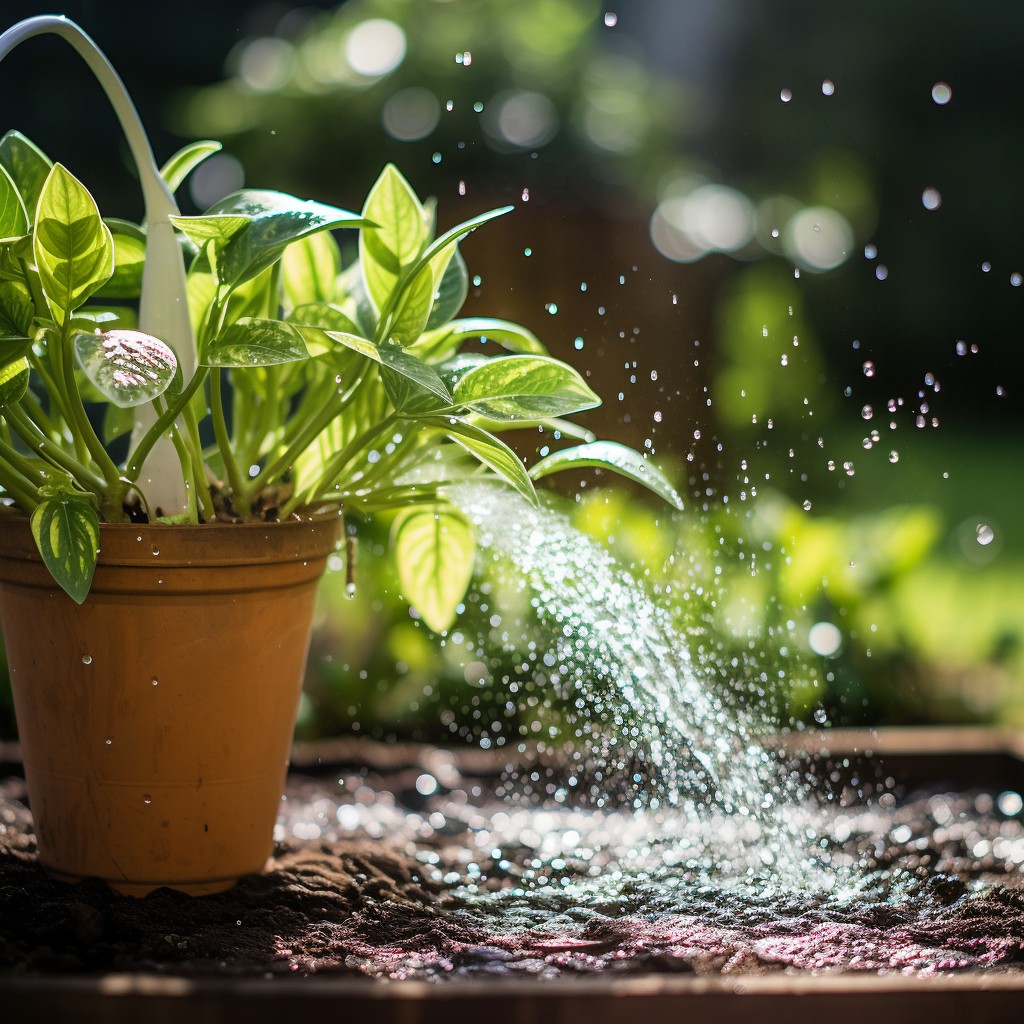Yes, it is okay to water house plants at night. Ensure the soil has proper drainage to avoid root rot.
Watering house plants at night is a common practice among many plant enthusiasts. Nighttime watering can be beneficial as it allows plants to absorb moisture without the risk of rapid evaporation caused by daytime heat. This can be especially useful in warmer climates or during summer months.
However, it’s crucial to ensure that the soil has good drainage to prevent water from stagnating, which can lead to root rot. By following these simple guidelines, you can keep your house plants healthy and thriving, even if you water them at night. Remember, happy plants often lead to a happier home environment.

Credit: english.elpais.com
Best Time To Water Plants
Watering house plants is essential. But what is the best time to water them? Timing can impact plant health. Understanding the benefits of morning and evening watering can help.
Morning Watering Benefits
Watering plants in the morning has many benefits:
- Absorption: Plants absorb water better in the morning.
- Evaporation: Less water evaporates in cooler morning temperatures.
- Disease Prevention: Leaves dry quickly, reducing fungal diseases.
Morning watering gives plants a full day to use the water. This helps them stay hydrated during hot afternoons.
Evening Watering Benefits
Evening watering can also be beneficial:
- Temperature: Cooler evening temperatures reduce water loss.
- Efficiency: Watering in the evening reduces immediate evaporation.
- Hydration: Plants can absorb water overnight.
Evening watering can help if mornings are too busy. Plants have all night to absorb water before the day starts.
| Time of Watering | Benefits |
|---|---|
| Morning |
|
| Evening |
|
Both morning and evening watering have their benefits. Choose the best time based on your schedule and plant needs.
Night Watering: Pros And Cons
Watering house plants at night has its own set of advantages and disadvantages. Understanding these can help you decide the best time for watering your plants. This section will explore the pros and cons of night watering.
Advantages Of Night Watering
There are several benefits to watering your plants at night. Here are the key advantages:
- Cooler Temperatures: Nighttime offers cooler temperatures, reducing water evaporation.
- Soil Absorption: Plants can absorb more water as it does not evaporate quickly.
- Less Stress: Watering at night can be less stressful for the plants.
| Advantage | Benefit |
|---|---|
| Cooler Temperatures | Reduces water evaporation |
| Soil Absorption | Improves water uptake |
| Less Stress | Better for plant health |
Disadvantages Of Night Watering
Despite the advantages, there are some drawbacks to night watering. Consider these disadvantages:
- Fungal Growth: Excess moisture at night can lead to fungal issues.
- Root Rot: Prolonged dampness may cause root rot.
- Insect Attraction: Moist soil can attract pests like gnats.
| Disadvantage | Risk |
|---|---|
| Fungal Growth | Increased risk of diseases |
| Root Rot | Potential root damage |
| Insect Attraction | Attracts pests |
Impact On Plant Health
Watering house plants at night can affect their health. This practice has both benefits and drawbacks. Understanding the impact helps you care for your plants better.
Root Health Considerations
Roots need oxygen to stay healthy. Night watering can lead to waterlogged soil. This reduces oxygen available to the roots. Lack of oxygen causes root rot, which can kill the plant.
Roots also absorb nutrients better during the day. Watering at night may hinder nutrient uptake. This affects the plant’s growth and overall health. Well-drained soil can help mitigate these issues.
Fungal Growth Risks
Moist environments are ideal for fungi. Night watering keeps the soil wet longer. This increases the risk of fungal diseases. Common fungal issues include mold, mildew, and root rot.
Leaf surfaces also stay wet longer with night watering. Wet leaves are prone to fungal infections. These infections can spread quickly and damage the plant. Always water the soil, not the leaves.
Using a fan or dehumidifier can help reduce moisture levels. Ensuring good air circulation also prevents fungal growth. Proper care keeps your plants healthy and vibrant.

Credit: www.amazon.com
Seasonal Watering Tips
Watering house plants correctly requires attention to seasonal changes. Plants need different care in summer and winter. Understanding these needs helps plants thrive.
Summer Watering Strategies
In summer, plants need more water. The hot weather makes soil dry faster. Watering in the evening is best. It prevents water evaporation. Check the soil daily. If it feels dry, water the plants.
- Water deeply to reach the roots.
- Use a watering can with a narrow spout.
- Avoid wetting the leaves to prevent fungus.
- Consider using a moisture meter for accuracy.
Winter Watering Adjustments
In winter, plants need less water. The cooler temperatures slow down their growth. Overwatering can cause root rot. Water in the morning. This allows the soil to dry during the day.
| Watering Frequency | Soil Check |
|---|---|
| Every 10-14 days | Check the top 2 inches |
| Use less water | Ensure soil is only slightly moist |
Keep plants away from cold drafts. Use room-temperature water. Cold water can shock the roots. Group plants together for humidity.
Watering Techniques
Understanding watering techniques can significantly improve the health of your house plants. Whether you choose to water at night or during the day, the method you use can make a big difference. This section delves into the best practices for surface watering and deep watering techniques.
Surface Watering Methods
Surface watering involves applying water directly to the topsoil. This method suits plants with shallow roots. Use a watering can with a fine spout for even distribution.
- Fill your watering can with room temperature water.
- Gently pour water over the soil surface until it feels moist.
- Ensure water reaches all parts of the soil.
Tip: Avoid overwatering to prevent root rot. Check soil moisture before adding more water.
Deep Watering Techniques
Deep watering ensures water reaches the plant’s root system. This method is ideal for plants with deeper roots. It promotes stronger root development.
- Water the plant slowly, allowing the soil to absorb water.
- Continue watering until excess water drains from the bottom.
- Allow the soil to dry out before the next watering.
Use a saucer under the pot to catch excess water. This keeps the environment clean and prevents water damage to surfaces.
Both watering techniques have their advantages. Choose the method that best suits your plant’s needs. Proper watering can enhance plant health and growth.
Common Watering Mistakes
Watering house plants may seem simple. Yet, common mistakes can harm plants. Understanding these mistakes helps keep plants healthy and vibrant.
Overwatering Issues
Overwatering is a frequent mistake. It leads to root rot. Roots need oxygen to survive. Too much water drowns the roots. Signs of overwatering include yellow leaves and a foul smell. Use pots with drainage holes. This ensures excess water escapes. Avoid watering if the soil is still wet. Check the soil moisture with your finger. If the top inch is dry, it’s time to water.
Underwatering Consequences
Underwatering is also harmful. Plants need water to thrive. Dry soil stresses plants. Signs of underwatering include wilting and brown edges on leaves. Regular watering schedules help. Use a calendar or reminder app. Ensure the soil is evenly moist. Avoid letting the soil dry out completely. Succulents are exceptions; they need less water. Adjust watering based on plant type.
Expert Opinions
Watering houseplants at night is a debated topic. Experts provide different views. Let’s explore insights from horticulturists and gardeners.
Horticulturist Insights
Horticulturists study plant growth. They focus on best practices for plant care. Some say night watering can cause problems. They believe it might lead to root rot. Wet roots and no sun can harm plants. The soil stays wet longer at night. This can create a breeding ground for fungi.
Others argue it’s fine to water at night. They state plants still absorb water even in darkness. These experts suggest using well-draining soil. They recommend monitoring moisture levels. This helps avoid waterlogging and keeps roots healthy.
Gardener Testimonials
Experienced gardeners share their stories. Many prefer morning watering. They find plants dry quickly in sunlight. This reduces the risk of disease. Some gardeners water at night due to busy schedules. They report no significant issues. They focus on proper drainage and not overwatering.
Gardener tips include:
- Check soil moisture before watering.
- Use pots with drainage holes.
- Water less in cooler months.
| Horticulturist View | Gardener View |
|---|---|
| Risk of root rot at night. | Morning watering is safer. |
| Plants absorb water anytime. | Night watering can be fine with care. |
| Monitor moisture levels. | Use well-draining soil. |
Both groups offer valuable advice. The key is understanding your plant’s needs. Follow these guidelines for healthy, thriving plants.

Credit: www.interiorcompany.com
Frequently Asked Questions
Is It Bad To Leave Plants In Water Overnight?
Leaving plants in water overnight can cause root rot. Ensure good drainage for healthy plant growth. Avoid waterlogging.
Can You Water Plants At 3am?
Yes, you can water plants at 3am. Early morning watering reduces evaporation and helps plants absorb water effectively.
Is It Ok To Water Plants At Night In Hot Weather?
Yes, watering plants at night in hot weather is generally OK. It helps reduce water evaporation and stress on plants.
Should I Water Indoor Plants At Night?
It’s best to water indoor plants in the morning. This allows leaves to dry, preventing mold. Evening watering can cause root rot.
Conclusion
Watering houseplants at night is generally safe. Ensure the soil drains well to prevent root rot. Morning watering is often better. Pay attention to your plant’s specific needs. Healthy plants contribute to a vibrant home. Happy gardening!

My mission is to help you bring the beauty of nature indoors with expert advice, detailed plant care guides, and creative design ideas.





Leave a Reply